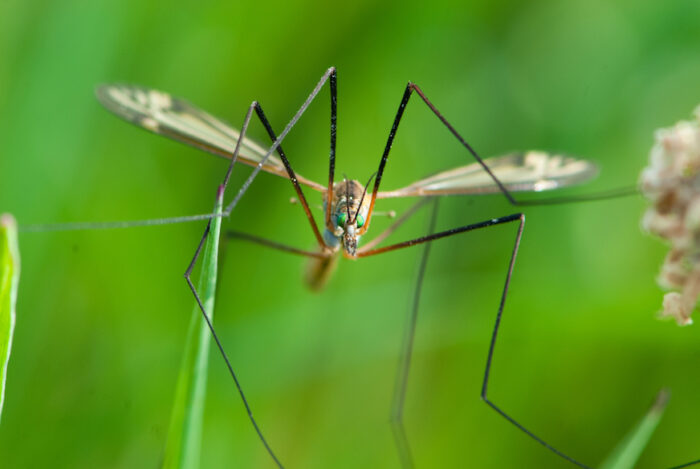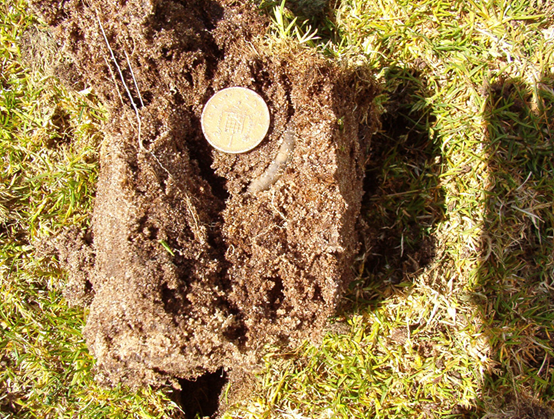Pesticide ban has resulted in ‘golf courses churned up by crane fly larvae’
Related Articles
Greenkeepers are struggling to cope with an infestation of crane fly larvae on golf courses, following a ban on pesticides, according to a newspaper report.
The Telegraph states that thousands of larvae laid by crane flies are chewing through grass at several golf clubs.
In 2016, chlorpyrifos, the chemical used to kill the larvae, was banned in the UK due to developmental issues it has been linked to in children, including brain damage, learning difficulties and ADHD.
The damage to golf courses and other sports fields comes after crane flies, commonly known as daddy long legs, lay their larvae, known as leatherjackets, under the turf.
The grubs then eat away at the roots of the grass, while damage is also done from above when predators such as badgers and birds dig up the grass to seek them out.
Greenkeepers have said a wet autumn and dry spring had exacerbated the problem, because a lack of grass roots to suck up moisture had led to sludgy conditions over the winter, while current dry weather means reseeding grass is difficult.
Another chemical remedy is available but it can only be used on very limited areas and at certain times of year, while a natural remedy, nematodes, is expensive and not always effective.

Ian Kinley, of Royal Porthcawl Golf Club in Wales, said lockdown had allowed him to tackle the problem by using plastic sheets placed on greens to trick the grubs into thinking it was night time, bringing them to the surface and allowing them to be cleared away, but that the culture needed to change.
“There needs to be an understanding of the problem and how there is not a lot we can do in the short term. You can implement cultural practices but it’s a long, drawn out process with no guarantees.
“End user expectation probably hasn’t changed, despite the fact we have these chemicals removed from use and the damage incurred as a consequence is significant,” he said.
Dan Kendle, greenkeeper at Newquay Golf Club, said he knew course managers who were considering quitting due to the stress caused by the infestations and the resulting criticism from golf club members.
“I’m absolutely devastated at the level of damage we’ve had on the course.
“It’s heartbreaking for my team to not be able to do anything about it and then you hear the comments that members are saying, just because they don’t understand,” he said.
Paul Shepherd, course manager at Nizels Golf Club in Kent, said golfers were moving clubs because of the issue only to find that their new courses were also plagued by it.
“We had a lot of our members leave. Because pardon the pun, the grass is greener somewhere else. And now this year, their grass isn’t quite so green as ours. So they come back.
“There have been a few clubs close because of it, I’m absolutely certain of it. And there will be more,” he said.
Karl Hansell, of the British and International Golf Greenkeepers’ Association, said a survey had found that 99 per cent of 400 respondents had had issues with the larvae.
“We didn’t use to get contacted about this problem, but now we’re seeing through our channels on a daily basis, members appealing for support, appealing for help.
“Greenkeepers are a passionate bunch about the courses they produce, often too much, and we’re getting a distressing number of people contacting us asking us for help,” he said.

Golf courses have become increasingly conscious of their role in encouraging wildlife and nature, he said, so most did not want a return of the chemical.
“Golfers want to see wildlife, now when they play, they want to see wildflowers in the rough areas. They’d rather that than a snooker table. So I think everybody’s moving in that direction,” he said.
Jim Croxton, chief executive of the British and International Golf Greenkeepers Association, added: “This is a very serious problem for golf courses. Golfers want near-perfect surfaces and to be able to enjoy their game as much as possible but the products that were used to control leatherjackets have been revoked.
“It’s a challenge as we are no longer able to just apply a treatment to a piece of turf and have a pest eradicated. We have an insecticide currently available, which is only allowed to be used at certain times, and does not really impact upon the leatherjackets problem.
“Other controls, such as putting sheeting down overnight, are useful but nothing like as effective as those we used to have and can have cost implications, which are then passed onto the golfers.
“The ban means the utopia of near-perfect surfaces may never really return. That’s a fundamental challenge as we’ve become used to sports being played on incredible surfaces.
“We’re not looking at Armageddon but what we are looking at is a natural phenomenon that is now incredibly difficult to manage and our members are pretty stressed about the situation. They are passionate about the courses they work on and it’s now about trying to explain to golfers why the course is at a different level to what they had come to expect. We need to be as innovative as we can to deal with this and we must also communicate with golfers.”

Robert Patterson, course manager at Royal Aberdeen Golf Club, said: “The restrictions on the use of these insecticides has caused big problems within our industry and some courses have experienced severe damage and turf loss due to high numbers of crane fly and resultant larvae in the soil eating stems and roots of turf.
“We have experienced problems with leatherjackets and there is very little we can do about it. Just the other day we were seeing full adult-sized larvae lying on top of greens and in bunkers. When they are that size they get pretty hungry and can eat a lot of roots and stems underneath the surface of the turf. It’s fair to say golfers may have to adjust their expectations of the quality of surfaces.”
The pesticide ban has led to increased numbers of birds who feed on the insects and wildflowers which previously could not thrive on courses. Croxton said: “I personally believe moves towards more naturalisation of the golfing landscapes is one positive aspect of what’s happened. Golf courses, for example in the central belt of Scotland, provide valuable wildlife corridors and we are seeing more biodiversity.
“But I also think if you play a golf course which isn’t what you were used to, I don’t really think it will be a great consolation that it is now covered in wildflowers.”
Alistair Beggs, head of agronomy at golf governing body The R&A, said: “We are aware changes to legislation governing use of pesticides have created challenges for some golf facilities, particularly the control of leatherjacket grubs. We have funded research to identify alternative treatments for grass as part of our Golf Course 2030 initiative, which aims to provide solutions to facilities and greenkeepers.”

























